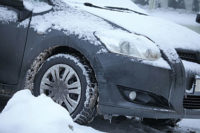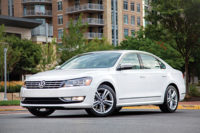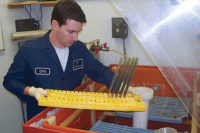The rapidly increasing ownership and production of automobiles in emerging markets such as China, India and Brazil is gradually transforming all stages of the supply chain. For automotive manufacturers, these changing economies not only represent differences in terms of consumer behavior and workforce culture, but present significant environmental challenges.
As the global shift towards emerging markets continues, a key quality control consideration is that material properties change under varying environmental conditions. And while this has always been the case, the expanding middle classes in these countries have increased expectations for the automotive products they buy. Whereas environmental wear-and-tear may have once been viewed as inevitable in certain climates, this more aspirational generation’s standards are moving in line with those of consumers in developed economies.
This inevitably impacts the environmental testing and analysis of component materials required by manufacturers. Through the provision of a documented basis of comparison and detailed information of materials, it plays a vital role in automotive production planning and specification. This ensures every part of a vehicle is suitable for its intended application, from the dry deserts of Arizona to the sweltering humidity of Shanghai.
Among the many environmental elements that are variables in analyzing and testing materials in differing climates, from temperature to humidity or precipitation, the degree of exposure to ultraviolet (UV) light inflicts some of the most potentially adverse effects on automotive products’ performance, primarily through polymer degradation.
What is Polymer Degradation and How Does it Affect Automotive Production?
UV exposure through sunlight affects all materials used in automobiles. Manufacturers must consider this not only in relation to the vehicle’s exterior, but also the interior due to the sun’s rays penetrating windshields and windows.
The majority of an automobile’s exterior is covered in a polymer coating such as paint, typically a powder coating. The polymer coating is used to change the color and gloss (reflectance) of the exterior, as well as forming a protective layer against the environment over its surface.
Interior components also consist of various polymers, from the plastics in the dashboard, steering wheel and handbrake, to the fabrics used in seats.
Exposing these components to excessive sunlight can result in polymer degradation, which changes the color, shape and tensile strength of materials used. This particular type of polymer degradation is referred to variably as photodegradation, photo-induced degradation or UV degradation—acknowledging the fact that the polymers are attacked by the UV radiation, causing them to crack or disintegrate if continuously subjected to the sun’s intense rays.
Effects of UV Exposure
One of the most common issues in automobile exteriors is the discoloring of paints and coatings. Photodegradation leads to instability in both the color and gloss properties of the coatings, the rate and extent to which depends on the coating’s ability to absorb UV light. The greater the amount of UV light absorbed, the faster the chemical bonds in the material are broken, and damage such as bleaching, fading and cracking occurs. Therefore, an effective coating acts as a reflective layer to slow the material’s absorption of UV radiation.
It is important to realize that the protective layer of coating does not ‘prevent’ photodegradation; it simply reduces the rate at which it occurs. The surface layer of coating is gradually degraded, meaning regular reapplication of a layer of exterior UV protective coatings may be necessary in more extreme environmental conditions. If not, damage to the structural integrity of the materials underneath the coatings is possible—for example brittleness and cracking—as oxidation weakens the resins binding the paint (at an increased rate under higher temperatures) and its properties become altered.
Just as UV protection does not fully prevent harmful sunlight reacting with exterior materials, automobile windshields and windows also have a limiting effect on UV degradation of interior components. Continuous exposure to sunlight affects the pigments and dyes in fabric materials, causing discoloration and loss of strength and flexibility. In addition, infrared heat dries out vinyl and other plastics to increase structural damage.
How are Materials Analyzed and Tested?
Materials analysis and testing of UV exposure is primarily conducted through a process known as accelerated weathering. This is the simulation of environmental conditions using special chambers and instruments to speed up the weathering process, measuring their effects on parts, components, products and materials.
There are key factors that form the evaluation of a materials test and analysis, which consider whether the material has changed from UV exposure, to what extent its properties have been altered, and how this change compares to alternative materials that could be used.
This forms a documented basis of comparison and detailed information of materials for manufacturers in the production of automotive products. As implied through the effects of UV exposure, limitation rather than prevention is the objective of quality control, meaning that the effects of degradation and discoloration must fall within an acceptable range as stated by the testing organization’s client.
There are a number of testing standards used to aid quality control, including:
-
ASTM D4587: American Society for Testing and Materials (ASTM) standard practice for fluorescent UV-condensation exposures of paint and related coatings (QUV)
-
ASTM D4329: ASTM standard practice for fluorescent UV lamp apparatus exposure of plastics
-
ASTM D4329: ASTM standard practice for Xenon arc testing of automotive coatings
-
ISO 4892: International Organization for Standardization (ISO) method specification for exposing specimens to Xenon-arc light in the presence of moisture—to reproduce the weathering effects that occur when materials are exposed in actual end-use environments
-
SAE J2020: Society of Automotive Engineers (SAE) method specification for operating conditions of fluorescent ultraviolet (UV) and condensation apparatus—used for the accelerated exposure of various automotive exterior components
-
SAE J2527: SAE method specification for operating conditions of Xenon arc testing of automotive exterior components.
-
SAE J2412: SAE method specification for operating conditions of Xenon arc testing of automotive interior components.
-
What Technology is Used?
Materials technology organizations’ capabilities in testing, measuring and analyzing UV degradation involve fluorescent, Xenon arc and Carbon arc UV testing machinery to simulate climatic environments.
In fluorescent testing equipment, bulbs are used to emit a controlled amount of light within a specified UV spectrum. Other variables can be combined, including heat and moisture, to more accurately simulate environmental conditions that will be present in the real world and can accelerate UV degradation. This type of testing is considered cost-effective and multiple samples can be exposed simultaneously. Fluorescent bulb type testing tends to be one of the most economical types of testing and single samples or multiple samples can be exposed at any one time.
Xenon arc machines, meanwhile, test the full radiation spectrum of simulated sunlight, using the noble gas in a sealed tube to create an arc light between two electrodes. This is regarded as the best type of equipment for testing discoloration in materials and coatings, due to the sensitivity of pigments and dyes to longer UV wavelengths. As with fluorescent testing, environmental variables such as temperature and moisture can be controlled to more accurately simulate the real-world conditions materials will be subjected to.
Xenon arc testing has generally replaced Carbon arc testing, as the latter simulates natural sunlight less accurately and produces a high-intensity of UV. It can still be used in some forms of testing, but mostly results in less reliable analysis and is decreasingly cost-effective.
What is the Future of UV Exposure Testing in Automotive Manufacturing?
Environmental testing and analysis by materials technology organizations, including polymer degradation through UV exposure, will be led by the global trends in the automotive manufacturing industry.
The increasing consumer automobile ownership in BRIC countries goes hand in hand with the ‘megatrend’ identified by consultancies Ernst & Young and PwC of greater collaboration between OEMs. There is a need for standardized production that provides the flexibility to more finely customize at later stages of the production process for local target markets. This means stakeholders at all stages of the supply chain will work more closely together to agree on common standards, and the sharing of platforms will lead to more standardized industry adoption of UV exposure durability to reduce research and development costs, risks, and lead times for production.
Furthermore, the exponential growth of local OEMs (partly) through acquisitions means that standardized quality control methods will become more widespread in these countries, as inevitable production centralization and economies of scale are applied.
UV exposure testing of polymer degradation forms a vital part of quality control and by increasingly standardizing their supply chain procedures, manufacturers will be better equipped to adapt to a transforming global automotive market.



